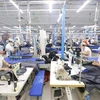Domestic latex and compound rubber producers said they are making losses and on the brink of shutting down their facilities after being hit hard by a hefty 3 percent export tax.
The export price for Vietnamese-made latex and compound rubber is usually 100-200 USD a tonne lower than rubber from Malaysia , Indonesia , and Thailand .
However, with the 3 percent export tax levied on the shipments, Vietnamese rubber prices increase by at least 80 USD a tonne, making Vietnamese rubber lose its competitive edge in overseas markets.
The Ministry of Finance decided to raise the export tax on natural and compound rubbers from zero to 3 percent as of December 8, 2011. The duty was imposed in a bid to "encourage the domestic rubber manufacturing sector, rather than focusing only on exporting natural rubber," the ministry said.
The tax rate was considered reasonable last year when rubber export prices peaked at 6,000 USD a tonne, allowing rubber exporters to initially enjoy profits despite the 3 percent tax. However, exporters said they suffere big losses this year as rubber prices fell to only 2,700 USD a tonne.
Nguyen Quang Hop, a representative for Hung Thinh Rubber Co, told Tuoi Tre (Youth) newspaper that rubber producers will suffer losses if they continue production and sell the products at old prices to clients. He said new machinery worth 400,000 USD that his company had imported from Sweden in late 2011 was now idle, as the 3 percent export tax forced his company to shut down the facility.
Le Ba Tho, a sales executive from the Tay Ninh Rubber Co, said his company has to switch to producing other rubber products to avoid the tax, although its export staple is latex, which accounts for 70 percent of total production.
Latex export turnover for his company thus dropped to only 30 – 40 percent in the first half of this year, said Tho.
However, he said, the new products have few markets, and his company has planned to return to latex production.
Rubber producers said it is unreasonable that only compound and latex rubber are subject to the export tax while many other kinds of export rubber are not.
Moreover, while 70 percent of Vietnamese rubber, mainly unprocessed types, are exported to China, the Government should apply incentive policies for exports of latex and compound rubber to avoid the risk of depending too much on the Chinese market for latex and compound rubber exports, Hop said.-VNA
The export price for Vietnamese-made latex and compound rubber is usually 100-200 USD a tonne lower than rubber from Malaysia , Indonesia , and Thailand .
However, with the 3 percent export tax levied on the shipments, Vietnamese rubber prices increase by at least 80 USD a tonne, making Vietnamese rubber lose its competitive edge in overseas markets.
The Ministry of Finance decided to raise the export tax on natural and compound rubbers from zero to 3 percent as of December 8, 2011. The duty was imposed in a bid to "encourage the domestic rubber manufacturing sector, rather than focusing only on exporting natural rubber," the ministry said.
The tax rate was considered reasonable last year when rubber export prices peaked at 6,000 USD a tonne, allowing rubber exporters to initially enjoy profits despite the 3 percent tax. However, exporters said they suffere big losses this year as rubber prices fell to only 2,700 USD a tonne.
Nguyen Quang Hop, a representative for Hung Thinh Rubber Co, told Tuoi Tre (Youth) newspaper that rubber producers will suffer losses if they continue production and sell the products at old prices to clients. He said new machinery worth 400,000 USD that his company had imported from Sweden in late 2011 was now idle, as the 3 percent export tax forced his company to shut down the facility.
Le Ba Tho, a sales executive from the Tay Ninh Rubber Co, said his company has to switch to producing other rubber products to avoid the tax, although its export staple is latex, which accounts for 70 percent of total production.
Latex export turnover for his company thus dropped to only 30 – 40 percent in the first half of this year, said Tho.
However, he said, the new products have few markets, and his company has planned to return to latex production.
Rubber producers said it is unreasonable that only compound and latex rubber are subject to the export tax while many other kinds of export rubber are not.
Moreover, while 70 percent of Vietnamese rubber, mainly unprocessed types, are exported to China, the Government should apply incentive policies for exports of latex and compound rubber to avoid the risk of depending too much on the Chinese market for latex and compound rubber exports, Hop said.-VNA



















